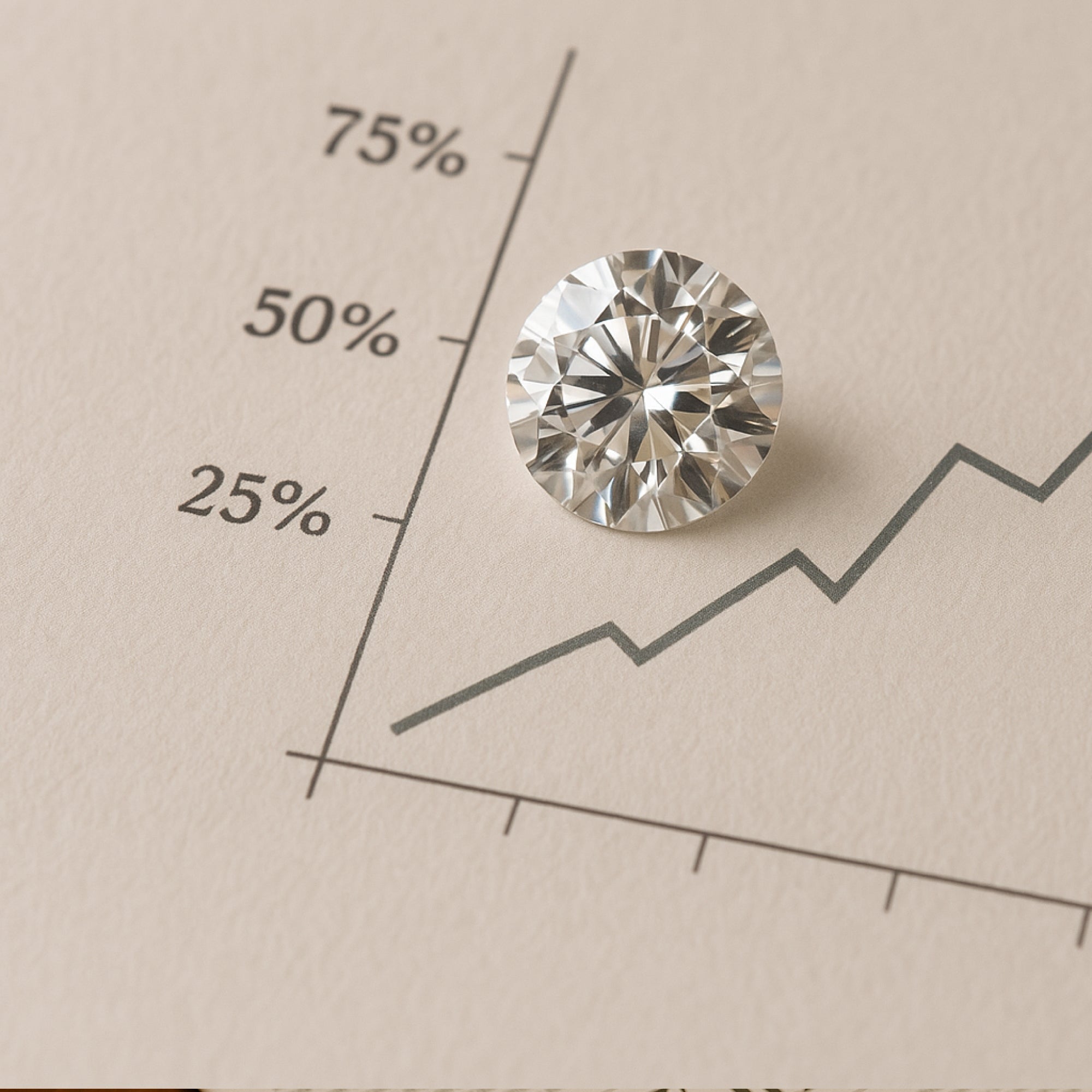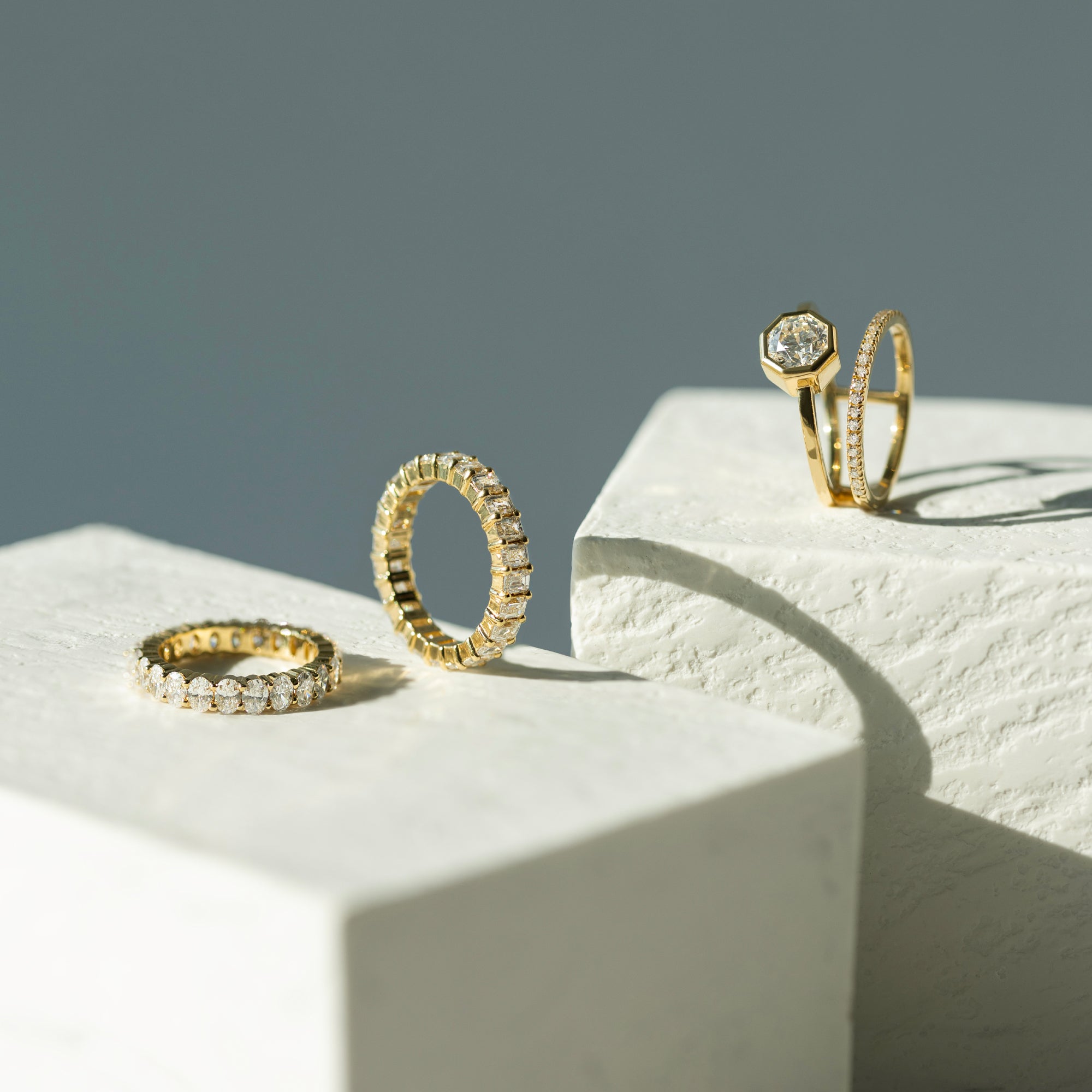The diamond industry has been buzzing with a question that's on every smart shopper's mind: are lab grown diamonds cheaper than natural diamonds? The answer is a resounding yes, and the savings are substantial enough to completely change how you approach diamond buying.
Lab grown diamonds represent a significant shift in the luxury market. They're not alternatives or compromises - they're real diamonds that happen to be created in laboratories rather than formed over billions of years underground. The price difference between lab grown and natural diamonds typically ranges from 80%-90% less, which means you can afford a much larger, higher-quality stone for the same budget.
Whether you're comparing a 1 carat lab-grown diamond vs natural price or exploring the cost difference between lab grown and natural diamonds across all sizes, understanding these pricing dynamics is essential for making an informed purchase decision.
This comprehensive guide will walk you through everything you need to know about lab diamonds vs natural diamonds pricing, so you can maximise your investment while getting the stunning diamond you've always wanted.
What Are Lab Grown Diamonds and Natural Diamonds?
Natural Diamonds: The Traditional Foundation
Natural diamonds are formed deep within the Earth's mantle over billions of years under extreme pressure and temperature conditions. These mined diamonds are extracted through complex mining operations, which explains their traditional positioning as rare and valuable stones. The geological journey of natural diamonds creates unique characteristics that reflect millions of years of Earth's history.
Lab Grown Diamonds: Modern Innovation Meets Timeless Beauty
Lab grown diamonds (also known as synthetic diamonds or lab created diamonds) are produced in sophisticated laboratory environments using advanced technologies like Chemical Vapor Deposition (CVD) and High Pressure High Temperature (HPHT). These processes replicate the exact conditions that create natural diamonds, but in a controlled setting that takes weeks rather than geological ages.
What's remarkable about lab grown diamonds is their authenticity. They're not diamond simulants or alternatives - they're genuine diamonds with identical chemical composition, crystal structure, and physical properties to natural diamonds. The only difference lies in their origin and the time required for formation.
Understanding the Science Behind Lab Diamonds
The technology behind lab grown diamonds is genuinely impressive. Both CVD and HPHT processes create diamonds that are chemically identical to natural ones - pure carbon arranged in a crystal lattice structure. This means they exhibit the same hardness (10 on the Mohs scale), brilliance, and fire as natural diamonds.
Advanced spectroscopy equipment can distinguish between lab grown and natural diamonds, but standard diamond testing equipment will confirm that both are real diamonds. The key point is that lab diamonds aren't imitations - they're the real thing, created through cutting-edge scientific processes. advanced spectroscopy, but to the naked eye, they're virtually indistinguishable.
Price Comparison: Lab Grown Diamonds vs Natural Diamonds
Understanding the Price Landscape
Lab-grown diamonds are consistently far more affordable than natural ones—typically 80–90% less for comparable quality. That price gap holds across color, clarity, and cut grades, often letting you step up in carat size or overall quality within the same budget. Note that prices can still vary widely based on the grading report (e.g., GIA vs. IGI), supplier margins, fluorescence, and other market factors.
|
Diamond Specifications |
Natural Diamond Price |
Lab Grown Diamond Price |
Your Savings |
|
1 Carat, |
$4,350 - $5,900 |
$400- $500 |
88% - 93% |
|
1.5 Carat, |
$11,000 - $13,000 |
$750 - $800 |
94%- 96% |
|
2 Carat, |
$22,450 - $28,600 |
$1,100 - $1,300 |
92%- 94% |
The Real-World Impact of These Savings
When examining a 1 carat lab-grown diamond vs natural price, the savings become immediately apparent. For a high-quality 1-carat stone, you might spend $5,900 on a natural diamond versus $500 on a lab grown diamond of identical specifications. This price difference allows you to either save substantially or invest in a larger stone that would have been beyond your original budget.
The savings become even more pronounced with larger stones. A 2 carat mined diamond price can easily exceed $28,000, while a comparable lab grown diamond might cost $1,300. This dramatic difference opens up possibilities that simply weren't accessible before.
Lab Grown Diamond Price Per Carat Analysis
The cost per carat for lab-grown diamonds varies by quality, but premium stones generally range from $800 to $3,000 per carat, while natural diamonds of comparable quality typically cost $4,000 to $15,000 per carat. This difference underscores the strong value proposition of lab-grown options. Another key distinction is how prices change with size: for lab-grown diamonds, increases in carat weight tend to follow a more linear pattern because production can scale to meet demand. In contrast, natural diamonds are a finite resource, and larger stones are far rarer, which drives prices up at an exponential rate as carat size increases.
These price differences mean that lab grown diamonds offer exceptional value for those seeking maximum impact within their budget. You can achieve the same visual impact and quality standards while allocating your budget more efficiently.
Why Are Lab Grown Diamonds Cheaper?
Production Efficiency and Technology
The primary reason why lab grown diamonds are cheaper lies in their production methodology. While natural diamonds require billions of years to form under specific geological conditions, lab grown diamonds can be created in 2-4 weeks using controlled laboratory processes. This fundamental difference in production time directly impacts the cost of lab created diamonds vs natural diamonds.
Operational Cost Comparison
The cost structure between mining and laboratory production differs significantly:
Natural Diamond Mining Requires:
- Extensive land acquisition and exploration
- Heavy machinery and infrastructure development
- Large workforce and ongoing operational expenses
- Environmental compliance and restoration costs
- Transportation from remote mining locations
- Unpredictable geological conditions
Lab Diamond Production Involves:
- Controlled laboratory environment
- Predictable energy consumption
- Streamlined workforce requirements
- Consistent production schedules
- Minimal transportation needs
- Scalable production capacity
These factors make the process more efficient and responsive compared to mining. However, it is important to note that the process is still not perfect. Large lab-grown diamonds with high clarity grades remain more challenging to produce, as the technology, while advanced, has yet to achieve flawless consistency at larger sizes.
Market Dynamics and Supply Control
The traditional diamond market has historically been controlled by a limited number of major players, creating artificial scarcity that supports higher prices. Lab grown diamonds operate in a more competitive market with flexible production capabilities that can respond to demand, resulting in more consumer-friendly pricing.
The Technology Investment Factor
While some ask "why are lab grown diamonds so expensive" given their laboratory origin, the answer lies in the sophisticated technology required to create them. The initial investment in CVD and HPHT equipment is substantial, but the operational efficiency more than compensates for these costs, allowing significant savings to be passed on to consumers.
Production Scalability Advantage
Lab grown diamonds benefit from scalable production methods. As technology improves and production scales increase, the cost to make lab grown diamonds continues to decrease, making them an increasingly attractive option for value-conscious consumers who don't want to compromise on quality.
Quality and Certification
Identical Grading Standards
Both lab grown and natural diamonds are evaluated using the same 4 Cs criteria:
- Carat: Weight measurement
- Cut: Quality of the diamond's proportions
- Color: Absence of color (D-Z scale)
- Clarity: Absence of inclusions and blemishes
Certification Bodies
Respectable organizations such as GIA (Gemological Institute of America) and IGI (International Gemological Institute) certify both lab-grown and natural diamonds using identical standards, ensuring consumers can trust the quality assessments regardless of the diamond’s origin. As of next year, GIA will introduce changes to its diamond grading reports for lab-grown stones, incorporating different terminology. This update is driven by more efficient internal procedures and cost reductions. We’ve covered why these changes aren’t a cause for concern in our blog here: Why GIA’s New Lab Diamond Reports Aren’t a Big Deal.
Quality Advantages of Lab Diamonds
Lab-grown diamonds are often praised for their consistent color, a result of the controlled conditions in which they are created. However, it’s important to note that many achieve their high color grades through post-growth treatments, and not all lab-grown diamonds are of superior quality. Just like natural stones, they can be found in a range of colors and clarities, and each one has its own unique characteristics. This is why lab-grown diamonds are still graded according to the 4Cs—cut, color, clarity, and carat weight—ensuring that buyers can assess and compare them just as they would with natural diamonds.
Value and Resale Considerations
Natural Diamond Resale Value
Natural diamonds are often said to hold their value better than lab-grown stones, largely because of their rarity and long-established place in the jewelry market. However, even natural diamonds typically resell for only a fraction of their original purchase price—most often between 20% and 40%—and only exceptionally rare gems in terms of size or color tend to appreciate meaningfully over time.
Lab Grown Diamond Value Retention
Lab-grown diamonds, on the other hand, follow a different path. Because they can be produced as needed and technology continues to advance, their market value over time can be more variable. Yet focusing solely on potential resale overlooks the real reason most people choose a diamond, especially for an engagement ring.
Investment vs. Personal Use
In reality, diamonds in general are not considered strong investment assets, as the majority will not gain value over time. Those looking for financial returns are likely to find better opportunities in other types of investments. A diamond’s true worth—whether natural or lab-grown—lies in the story it tells, the sentiment it carries, and the personal meaning it holds for the wearer.
Those purchasing diamonds for personal enjoyment, engagement rings, or other jewelry, lab grown diamonds offer exceptional value by providing the same beauty and durability at a fraction of the cost.
Are Lab Grown Diamonds Worth It?
The value proposition of lab grown diamonds depends on your priorities:
- Maximum size for budget: Lab diamonds allow you to afford larger, higher-quality stones
- Ethical considerations: Lab diamonds avoid mining-related concerns
- Immediate satisfaction: Get more diamond for less money upfront
Environmental and Ethical Considerations
Environmental Impact
Lab grown diamonds have a significantly smaller environmental footprint:
- No land excavation or habitat destruction
- Reduced water usage
- Lower carbon emissions per carat
- No mining waste or tailings
Ethical Sourcing
Lab diamonds eliminate concerns about:
- Conflict or "blood" diamonds
- Mining labor conditions
- Community displacement
- Political instability in mining regions
Growing Consumer Preference
Increasingly, consumers are choosing lab grown diamonds for ethical reasons, viewing them as a more responsible choice that aligns with environmental and social values.
Making the Right Choice for Your Budget
When Lab Grown Diamonds Excel
Lab grown diamonds offer exceptional value for buyers who want to maximise their investment. They're particularly appealing when you:
- Want to achieve a larger carat size within your budget
- Value cutting-edge technology and innovation
- Prioritise environmental and ethical considerations
- Are purchasing for personal enjoyment rather than investment purposes
- Appreciate getting premium quality at accessible prices
Practical Considerations for Natural Diamonds
Natural diamonds may be preferable for those who:
- Value the traditional rarity and geological formation story
- Factor in how natural diamonds are perceived in the resale market
- Prefer established luxury market positioning
- Are following cultural or family traditions
The Smart Shopper's Approach
The decision between lab grown vs natural diamonds ultimately depends on your personal priorities and budget allocation. Lab grown diamonds allow you to access larger, higher-quality stones that might otherwise be beyond your budget. This means you can achieve the visual impact and quality you want while making a more efficient financial decision.
Many of our clients find that lab grown diamonds offer the perfect balance of luxury, quality, and value. You're not compromising on beauty or durability - you're simply making a smarter financial choice that gives you more options within your budget.




